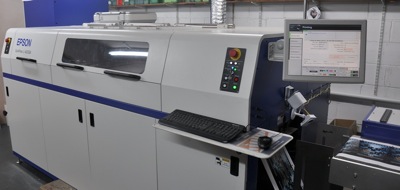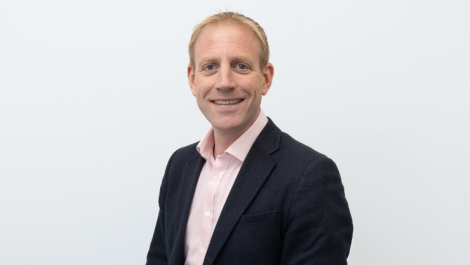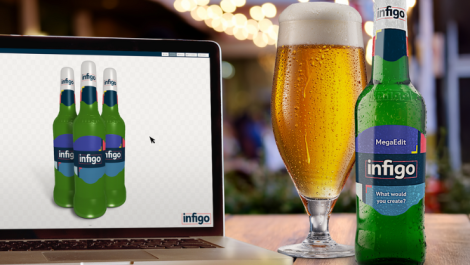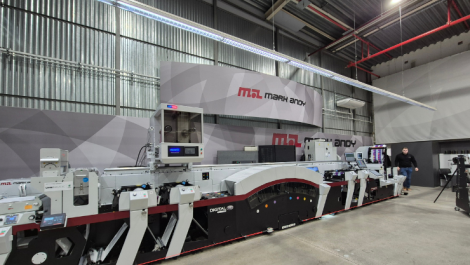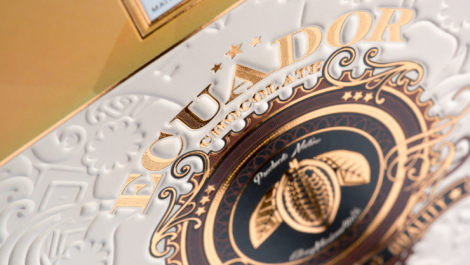Superfast Labels is a small family owned converter based in Kent that specialises in short run, fast turnaround labels and stickers for a variety of food, pharma, media and consumer products. If a book has a sticky label on it is likely that Superfast produced it.
The company was started in the early 80s as a generic printer, then found a niche in self-adhesive labels and bought its first flexo press line and converting unit. Today there are 12 staff and a turnover around £1 million, with four Nilpeter flexo machines, in-house platemaking and the UK’s first Epson SurePress 4033A inkjet label press.
Andrew Miller is the managing director and he proudly showed off his business to DL&P.
There were many reasons to consider digital. Typical labels that the company was being asked to produce were becoming more complex to run in flexo. Designers provided four colour files with a range of unspecified colours, often no Pantone reference with the request to ‘Please match the screen’. As Mr Miller commented: ‘Which screen?’
He continued, ‘We started to buy in digital work from the trade, and we learned the strengths of the leading digital equipment. The volumes were steadily rising and we would send out maybe 25 to 30 digital jobs per week. We looked at various possibilities to bring this back in-house, not purely from a cost consideration but to regain control.’
The digital press, together with off line finishing, was bought from the Epson stand at Labelexpo last year. Superfast was very limited for space and the height of the room, previously a paper store, didn’t allow the larger footprint or height of some alternatives. Mr Miller admitted he wasn’t aware of the SurePress before and it really was a walk up sale, determined by the compact press size and the quality. The press was installed in November 2011 and is very straightforward for management and operators.
The front end is the same as the flexo side, from Esko. The company uses its own MIS written in-house as a database, linked to several trade quoting software routines.
Epson provides a three year warranty for the machine that includes heads, with a support contract that provides a two hour engineer response. There is remote access with engineers in Japan taking notice, and the company has installed a webcam to show real time performance for approved visitors. The SurePress 4033A is different to most inkjet narrow web machines. It uses water based inks rather than UV and it is not a single pass design. The 330 mm maximum width substrate is advanced onto the print bed where it is held under vacuum. The six colour print head carriage passes over the stock, printing in multiple passes according to the quality requirement. There are three modes, four, six and eight passes, bi-directionally. Then the stock is advanced, passing through a warm air drier to dry the water based inks before re-reeling so speed varies from 3 to 5 metres per minute. Superfast handles finishing off line with lamination, varnishing, die cutting, slitting and re-reeling. Most jobs are run in six pass mode and Mr Miller is pleased with the results but more importantly so are his customers. ‘Unlike some digital results we do not see any screening in flat tints, they are closer to the solids from flexo,’ he said.
The company is standardising stocks with seven or eight regular media, gloss, satin or matt, peelable or permanent and it is testing a textured wove. The runs are ganged to keep the stock changes to a minimum and the company is steadily ramping up capacity, currently at some 75% of a single shift with the press running through breaks. The 15 minute shut down routine is the main manual operation, the machine performs regular cleaning, maintenance and calibration. Ink can be replaced on the fly with Epson recycling the empty cartridges.
The digital jobs are very short run, averaging just 65 linear metres and the in-house developed MIS provides quotes and job bags, tracking production in real time to control the high numbers of jobs and make sure delivery times are met. It is quick and easy to use, quite visual with a simple traffic light system showing jobs in hand and completed. Superfast does not calculate individual job ink usage. It takes a systematic approach, pricing at market rates using a trade price calculator. ‘It results in profitable work,’ said Mr Miller, showing a report detailing the five million labels (5.13 metres to be precise) that have been run in the first five months of operation. There is a rapid ramp up of volume, currently the digital rate is almost 25% of the output value, but growing. As experience builds up there is an impressive array of performance statistics, comparing the costs of outwork, digital and flexo, helping drive a continual improvement programme.
The job being run during our visit is typical. The customer wanted 500 special wine bottle labels for an awards ceremony. The enquiry arrived at 6 pm, with a quick turnaround of quote and a verbal ‘we think so’ then and approval 11 am the next day when the artwork as a PDF was receiving bed. No proofs. It was printed at 3 pm taking about 20 minutes, then die cut, slit, rewound and out the same afternoon. And that is quite typical with a four day visibility of work, only occasionally do customers book a forward load.
So what about the future? ‘We are very happy with the progress to date, and are starting to think about a second machine,’ stated Mr Miller. ‘I would like a faster machine and white would be an advantage for foils and coloured stock but we didn’t want to wait.
We were impressed with the fixed head SurePress X for the faster speed at the quality level at drupa.’
The company is located next to Sittingbourne stadium, home of Sittingbourne FC and a greyhound race track. However, a visit to Superfast fast and you quickly realise this converter is definitely not going to the dogs.



